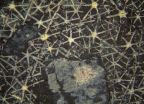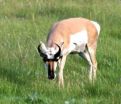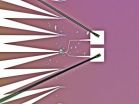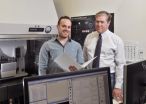(Press-News.org) The evolution of the first animals may have oxygenated the earth's oceans – contrary to the traditional view that a rise in oxygen triggered their development.
New research led by the University of Exeter contests the long held belief that oxygenation of the atmosphere and oceans was a pre-requisite for the evolution of complex life forms.
The study, published today in the leading journal Nature Geoscience, builds on the recent work of scientists in Denmark who found that sponges – the first animals to evolve – require only small amounts of oxygen.
Professor Tim Lenton of the University of Exeter, who led the new study, said: "There had been enough oxygen in ocean surface waters for over 1.5 billion years before the first animals evolved, but the dark depths of the ocean remained devoid of oxygen. We argue that the evolution of the first animals could have played a key role in the widespread oxygenation of the deep oceans. This in turn may have facilitated the evolution of more complex, mobile animals."
The researchers considered mechanisms by which the deep ocean could have been oxygenated during the Neoproterozoic Era (from 1,000 to 542 million years ago) without requiring an increase in atmospheric oxygen.
Crucial to determining oxygen levels in the deep ocean is the balance of oxygen supply and demand. Demand for oxygen is created by the sinking of dead organic material into the deep ocean. The new study argues that the first animals reduced this supply of organic matter – both directly and indirectly.
Sponges feed by pumping water through their bodies, filtering out tiny particles of organic matter from the water, and thus helping oxygenate the shelf seas that they live in. This naturally selects for larger phytoplankton – the tiny plants of the ocean – which sink faster, also reducing oxygen demand in the water.
By oxygenating more of the bottom waters of shelf seas, the first filter-feeding animals inadvertently increased the removal of the essential nutrient phosphorus in the ocean. This in turn reduced the productivity of the whole ocean ecosystem, suppressing oxygen demand and thus oxygenating the deep ocean.
A more oxygen-rich ocean created ideal conditions for more mobile animals to evolve, because they have a higher requirement for oxygen. These included the first predatory animals with guts that started to eat one another, marking the beginning of a modern marine biosphere, with the type of food webs we are familiar with today.
Professor Lenton added: "The effects we predict suggest that the first animals, far from being a passive response to rising atmospheric oxygen, were the active agents that oxygenated the ocean around 600 million years ago. They created a world in which more complex animals could evolve, including our very distant ancestors."
Professor Simon Poulton of the University of Leeds, who is a co-author of the study, added: ″This study provides a plausible mechanism for ocean oxygenation without the requirement for a rise in atmospheric oxygen. It therefore questions whether the long-standing belief that there was a major rise in atmospheric oxygen at this time is correct. We simply don't know the answer to this at present, which is ultimately key to understanding how our planet evolved to its current habitable state. Geochemists need to come up with new ways to decipher oxygen levels on the early Earth.″
INFORMATION:
The article, 'Co-evolution of Eukaryotes and Ocean Oxygenation in the Neoproterozoic' by Timothy M. Lenton, Richard A. Boyle, Simon W. Poulton, Graham A. Shields-Zhou and Nicholas J. Butterfield is published in Nature Geoscience doi: 10.1038/ngeo2108
First animals oxygenated the ocean, study suggests
2014-03-09
ELSE PRESS RELEASES FROM THIS DATE:
In grasslands remade by humans, animals may protect biodiversity
2014-03-09
COLLEGE PARK, Maryland – A comparative study of grasslands on six continents suggests there may be a way to counteract the human-made overdose of fertilizer that threatens to permanently alter the biodiversity of the world's native prairies.
The solution is one that nature devised: let grazing animals crop the excess growth of fast growing grasses that can out-compete native plants in an over-fertilized world. And grazing works in a way that is also natural and simple. The herbivores, or grazing and browsing animals, feed on tall grasses that block sunlight from reaching ...
New bioinformatics tool to visualize transcriptomes
2014-03-09
ZENBU, a new, freely available bioinformatics tool developed at the RIKEN Center for Life Science Technology in Japan, enables researchers to quickly and easily integrate, visualize and compare large amounts of genomic information resulting from large-scale, next-generation sequencing experiments.
Next-generation sequencing has revolutionized functional genomics, with protocols such as RNA-seq, ChIP-seq and CAGE being used widely around the world. The power of these techniques lies in the fact that they enable the genome-wide discovery of transcripts and transcription ...
Sun's energy influences 1,000 years of natural climate variability in North Atlantic
2014-03-09
Changes in the sun's energy output may have led to marked natural climate change in Europe over the last 1000 years, according to researchers at Cardiff University.
Scientists studied seafloor sediments to determine how the temperature of the North Atlantic and its localised atmospheric circulation had altered. Warm surface waters flowing across the North Atlantic, an extension of the Gulf Stream, and warm westerly winds are responsible for the relatively mild climate of Europe, especially in winter. Slight changes in the transport of heat associated with these systems ...
Spread of antibiotic resistance understood by unravelling bacterial secretion system
2014-03-09
The system that allows the sharing of genetic material between bacteria – and therefore the spread of antibiotic resistance – has been uncovered by a team of scientists at Birkbeck, University of London and UCL.
The study, published today in Nature, reveals the mechanism of bacterial type IV secretion, which bacteria use to move substances across their cell wall. As type IV secretion can distribute genetic material between bacteria, notably antibiotic resistance genes, the mechanism is directly responsible for the spread of antibiotic resistance in hospital settings. ...
Atomically thin solar cells
2014-03-09
It does not get any thinner than this: The novel material graphene consists of only one atomic layer of carbon atoms and exhibits very special electronic properties. As it turns out, there are other materials too, which can open up intriguing new technological possibilities if they are arranged in just one or very few atomic layers. Researchers at the Vienna University of Technology have now succeeded for the first time in creating a diode made of tungsten diselenide. Experiments show that this material may be used to create ultrathin flexible solar cells. Even flexible ...
U of M-led study finds herbivores can offset loss of plant biodiversity in grassland
2014-03-09
Two wrongs may not make a right. But when it comes to grassland plant species diversity, it just might. Two impacts often controlled by humans — being fertilized and being eaten — can combine to the benefit of biodiversity, according to an innovative international study led by U of M researchers Elizabeth Borer and Eric Seabloom.
The findings, published March 9 in the online edition of Nature in advance of print publication, are important in a world where humans are changing both herbivore distribution and the supply of nutrients like nitrogen or phosphorus, and where ...
UNC researchers create new tool to unravel the mysteries of metastasis
2014-03-09
VIDEO:
When the drug analog of rapamycin binds to and activates the Src kinase, the cell reacts in real time, revealing Src's role in metastasis.
Click here for more information.
March 10, 2014
CHAPEL HILL, N.C. – Researchers at the UNC School of Medicine have devised a new biochemical technique that will allow them and other scientists to delve much deeper than ever before into the specific cellular circuitry that keeps us healthy or causes disease.
The method – developed ...
Stem cell study opens door to undiscovered world of biology
2014-03-09
DALLAS – March 9, 2014 – For the first time, researchers have shown that an essential biological process known as protein synthesis can be studied in adult stem cells – something scientists have long struggled to accomplish. The groundbreaking findings from the Children's Medical Center Research Institute at UT Southwestern (CRI) also demonstrate that the precise amount of protein produced by blood-forming stem cells is crucial to their function.
The discovery, published online today in Nature, measures protein production, a process known as translation, and shows that ...
The Crab Run & Seafood Festival is the Official Season Kickoff of Pacific Fisheries LLC and is an Annual Toast of the Seafood Season in America.
2014-03-09
Announcing the annual Crab Run & Seafood Festival with stops in 6 metro cities throughout the United States. The festival opens to the West Coast in late April.
The Crab Run & Seafood Festival is the official season kickoff of Pacific Fisheries LLC and is an annual toast of the seafood season in America. It is a one-day sensational crab tasting, mainly crab with chef demos, educational events and family fun. Opening weekend takes place Saturday, April 26, 2014 and will be held, rain or shine, at the Engelmann Cellars 3275 N Rolinda Ave, Fresno, CA. Event runs12:00 ...
NKSJ Holdings Awarded "Bronze Class" in RobecoSAM's Sustainability Rating
2014-03-09
NKSJ Holdings, Inc has received the RobecoSAM Bronze Class distinction in RobecoSAMfs Corporate Sustainability Assessment.
Having earned the RobecoSAM Bronze Class distinction in 2013, NKSJ Holdings has been recognised for the fourth consecutive year since the company was founded in April 2010, and for the seventh consecutive year including distinctions received by its subsidiary, Sompo Japan Insurance Inc. (hereinafter gSompo Japanh).
NKSJ Holdings will continue to play an active role in efforts to resolve social issues and contribute to the building of a sustainable ...






